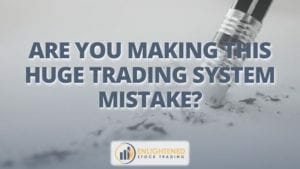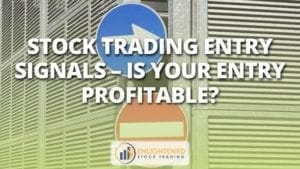If you’re on the path to learn stock trading or still learning how to trade in stocks, using a stop loss is probably the number one rule that has been hammered into you. We accept statements like “Never place a trade without placing your stop” at face value because we all know you have to have a stop loss right?
But is conventional wisdom really true? Should every trade really have a stop loss? In this article I am going to step on some dangerous ground in the eyes of some traders.
One lesson I have learned from being a stock trader for the last 20 years is that every assumption and belief must be tested to ensure we are not blindly accepting something as fact when it is really just folk law.
Lets start with the basics…
An initial stop loss is a sell order you place with your broker that is triggered if your trade moves a certain distance against you. The conventional wisdom is that as soon as you enter your trade you should also place a stop loss order with your broker. The idea behind this is if your trade starts losing you too much money it will automatically be closed out so the loss doesn’t keep growing and damage your account.
Most new traders lose money because they don’t control the size of their losses. That is why stop losses are considered so important. Stop losses address one of the primary causes of trader failure – letting losses grow too large. After all, if you have a stop loss you can’t keep holding and hoping because the stop will get you out of your trade automatically.
What problems can stop loss orders introduce?
The problem that stops can introduce warrant some attention. There are two issues:
- Slippage
- Gaps
- Intraday noise
Slippage is a problem because the way a stop loss order works is your broker holds the order out of the market until the stop loss level is hit. As soon as the stop loss order level is hit the broker places your sell order into the market as a ‘Sell at market’ order. A market order will execute at the best available price in the market, regardless of how unfavorable that might be.
Considering that stop loss orders get triggered when the price is moving down, slippage can be a real problem. Price is falling which means buyers are pulling back and hoping to get in at lower prices and sellers are panicking and lowering their price to get out. Your sell order dropping into the market adds fuel to the fire and pushes the price down further. In a panicking market you will often find that your stop loss order is executed at a level well below your stop loss level. That is called slippage, and that erodes your profitability dramatically if you are not careful.
If your stop loss it triggered by an overnight gap your loss can be a lot larger than you might expect. In the image below we have a stop loss placed at $126, but the day the stop is triggered the price gaped down through that level and opened at $120.48. With this sort of gap down you probably would not have been executed at the opening price because the market was moving fast. You would more likely have been executed at some price between the open ($120.48) and the Low ($116).

Intraday noise can also be a real problem for stop loss orders. The example below shows how on occasions your stop loss can get triggered by a sudden price spike down that is short lived. This is the most frustrating part of using stop loss orders because they get you out of the trade only for you to watch from the sidelines as the price moves immediately higher.

These examples illustrate some of the problems with placing your stop losses in the market. So while using stop loss orders can protect you, there are clearly some situations where there are undesirable consequences.
Evaluation of 3 approaches to stop losses using a simple trading system
Given there are some advantages and disadvantages to using stop losses, it is worth evaluating quantitatively whether using them is going to give you the best return. To demonstrate this I am going to use a very simple trend following system on Australian stocks and backtest 3 different approaches using Amibroker.
The system buys on the next bar at the open if…
- Today’s close is the highest close in the last 200 bars
- The 20 day average dollar turnover is more than $500,000 per day
- The ATR(14) is less than 5% of the share price
- The All Ordinaries Index is above its 200 day EMA
- Put 5% of equity into each trade
The system sells on the next bar at the open if…
- The closing price crosses below its 200 bar simple moving average
The stop loss we are testing is 4 times the Average True Range below the entry price.
Here are the different stop loss approaches I am comparing in this article:
- In market stops: The traditional approach of placing your stop loss with your broker.
- Next bar on open stops: This is a chart based stop where you draw the stop level on your chart and if it is touched during the day then you exit manually on the next bar at the open.
- Don’t use stops at all: In this approach you do not use a stop loss and simply exit when your indicator / rule based exit triggers a sell signal.
Backtesting in Amibroker from 1990 to present here is what we find for these three options tested on all ASX stocks:

This clearly shows that (for this particular trading system), using in market stops is the worst of the three approaches evaluated. The best risk adjusted return comes from using next bar on open stops and the highest compound annual return comes from using no stops at all!
Does this mean you should stop using stops? Not necessarily, because this introduces other risks to your trading.
Risks of not using in market stop loss orders when you learn stock trading
The trouble is not using in market stop loss orders introduces additional risks into your trading. First and foremost, if you don’t use in market stops, your performance relies on you monitoring your trades correctly every day. If you skip checking your positions for a day or more there is a chance you will miss seeing that the stop loss was triggered and you could end up with a nasty loss.
This could certainly be a problem in a number of circumstances such as:
- You just forget to check your trades
- You are sick or injured
- You have a technology failure and you can’t access your data or account
- Many other situations
There is also a trader discipline risk of not using in market stops. If you lack the discipline to take the next bar on open stop loss when it is triggered then you could also end up with a nasty loss that is much bigger than expected. In market stop loss orders do not rely on your manual intervention so they eliminate this risk.
Conclusion on the use of stop loss orders
It is fair to say that using an in market stop loss is not always going to give you the best performance from your trading system. Slippage from these orders reduces your profits (not modelled in this article – but this can be significant), and the impact of intraday noise triggering your stops can be huge.
My belief is that it is wrong to say “always use a stop loss”… there are clearly situations where using in market stop losses is suboptimal. However you need to make the decision about whether to use stops, and how to use them with your eyes wide open after considering three important factors:
- Whether your trading system backtests better with in market / next bar on open / no stops at all
- Whether you have the discipline to act on chart based stops
- Whether the additional risks you take by not having in market stops are justified by the performance uplift
If in doubt, use in market stop loss orders because at least they will keep your account alive and in the game no matter what happens. However, I recommend you don’t do this blindly – Backtest everything and make your own informed decision rather than just acting blindly according to trading folk law.
About The Author:
Adrian Reid has over 18 years of trading experience and has been a profitable systematic trader for over 15 years. He trades for a living and spent most of 2019 traveling with his wife and two kids and trading from the road. He is the founder and trading coach at Enlightened Stock Trading where for the last 5 years he has been mentoring stock traders globally.
For trading systems and code from previous YTE articles along with free training and Cheat Sheets to help you with the process outlined in this article, go to www.enlightenedstocktrading.com/yte1 Adrian also welcomes questions and comments from YTE readers and can be contacted directly at [email protected]









Share This
Share this post with your friends!